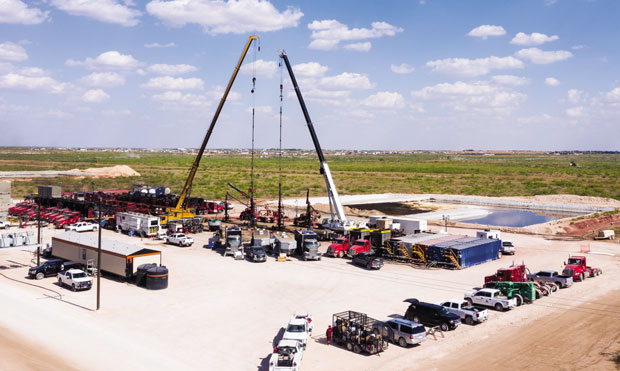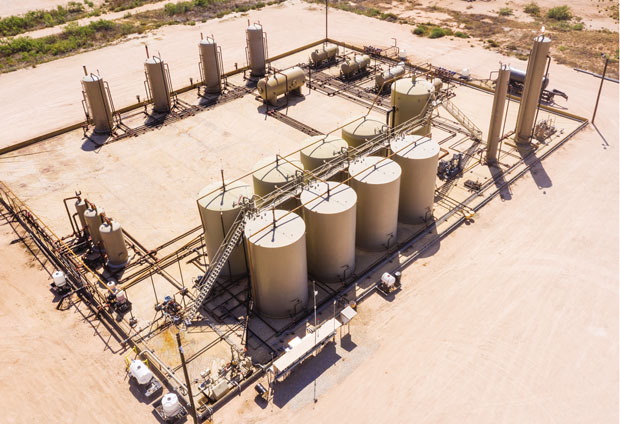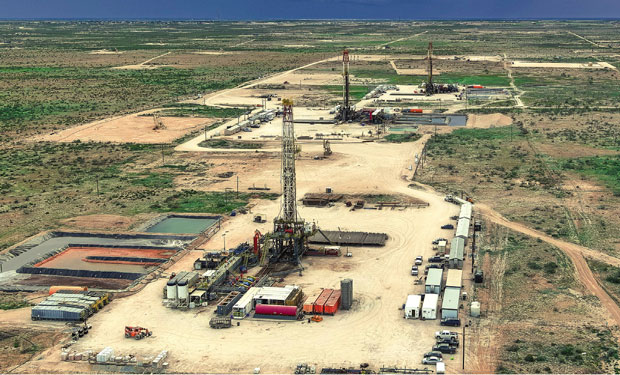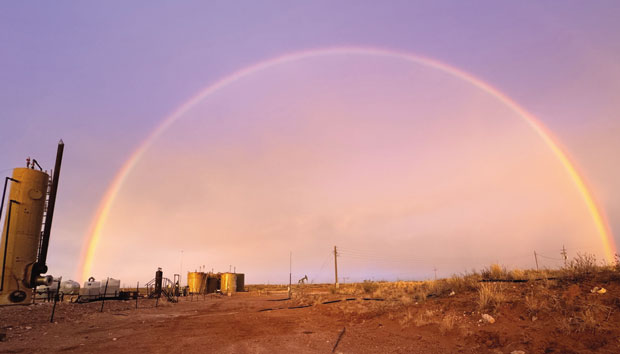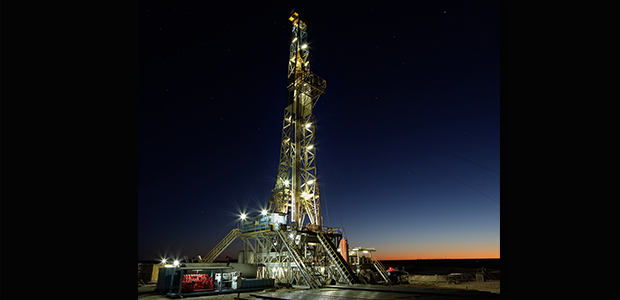
Diverse Roster of Projects Keeps Oil And Gas Output On The Rise In The Permian
By Danny Boyd
The Shale 2.0 era is in full swing in all parts of the Permian Basin. It is home to the motherlode of tight oil resources and also has a wealth of natural gas reserves. Stacked benches across multiple sub-basins give the Permian the unique ability to not only produce nearly twice as much oil as all other U.S. shale plays combined, but also flow more than 25 billion cubic feet of natural gas per day—second only to the Appalachian Basin and its mighty Marcellus and Utica gas formations.
By the end of 2025, the U.S. Energy Information Administration projects that the Permian’s oil and gas-rich geology will push year-over-year oil output higher by 300,000 bbl/d to 6.6 million bbl/d (accounting for more than half of total daily U.S. oil volumes!) and ramp marketed gas production by 1 Bcf/d to just a notch below 26 Bcf/d.
As development activities shift to infill and offset acreage, higher-density drilling with long-lateral horizontal well architectures is helping large pure-play operators like Diamondback Energy, Inc. fully leverage fresh major acquisitions to optimize well productivities and boost recovery rates across massive blocks of contiguous acreage.
At the same time, smaller players such as Birch Resources, FireBird Energy II and EON Resources are also deploying advanced technologies at scale to develop their leaseholds by exploiting intra-bench and uphole horizons, jockeying for position in the producing property A&D space, and even bringing the techniques perfected in horizontal tight oil plays to bear in more “conventional” plays traditionally drilled with vertical wells and legacy fields undergoing enhanced recovery.
There is truly something for everyone in the world’s most productive oil and gas province, from the organic-rich Wolfcamp and Bone Springs groups in the Delaware Basin to prolific Spraberry and Wolfcamp benches in the Midland Basin and the workhorse San Andres on the Northwest Shelf.
Tank Full Of Oil
Diamondback Energy continues to raise the performance standard in the Midland Basin’s Lower Spraberry and Wolfcamp A and B zones but has also moved full force into developing the Middle Spraberry, Jo Mill and some Upper Spraberry while adding the Wolfcamp D, says President Kaes Van’t Hof. He adds that while targeted Barnett and Woodford shale development is still in an exploratory phase on the company’s leases, work is starting to shift to a development mode in benches that are likely to provide prolific over the next decade.
“The beauty of the basin is that it is just this big tank full of oil with all these different zones,” Van’t Hof remarks. “We have been fortunate that every time that the drill bit goes into a new zone, it has been proven to be economic over time.”
Diamondback Energy is completing 3,500 lateral feet a day using simulfrac operations across its large leasehold, where average lateral lengths are projected at 11,800 feet for new wells drilled in 2025.
Diamondback has no shortage of locations to drill in the Midland Basin after closing last year on a headliner acquisition of private powerhouse Endeavor Energy Resources LP, which had been founded in 1979 by the late Autry Stephens, a legendary wildcatter and industry entrepreneur.
Following the $26 billion acquisition, Diamondback’s core drilling locations expanded from 3,800 to 6,100 at a breakeven West Texas Intermediate oil price below $40/bbl. Prior to the merger, Endeavor had operated exclusively in the Midland sub-basin, while Diamondback’s assets spanned the Midland and Delaware sub-basins along with the Central Basin Platform.
The joined forces of the two strong, established companies results in a lease position of 870,000 net acres and average estimated oil production of 473,000 bbl/d during the fourth quarter of 2024. Diamondback expects to generate pro forma production of 800,000-825,000 barrels of oil equivalent in 2025 with a capital budget of $4.1 billion-$4.4 billion.
Across its position, Van’t Hof says average breakeven costs under $40 a barrel are continually reinforced by service company ingenuity. Compared to 23 rigs drilling 300 wells in 2019, this year 16-18 rigs will drill some 500 wells for the Midland-based company. Before year-end 2024, wells on original Endeavor acreage were being drilled at an average cost of $600 per lateral foot, compared with an expected $625/lateral foot, he notes.
Learning Something New
Four simulfrac crews already are completing 3,500 lateral feet a day, up 15% from the original plan. Average laterals in 2025 are projected at 11,800 feet. Key synergies now deployed across joint operations include clear fluids for all drilling operations and a post-completion drill-out process developed by Endeavor.
“The Endeavor team was doing some things on the post-completion side with drill-outs that definitely made sense to us and represented a better, more efficient, and lower-cost way of doing things,” Van’t Hof explains. “At Diamondback, every time we do a deal, we end up learning something new and checking our egos at the door.”
After closing on its acquisition of Endeavor Energy Resources last year, Diamondback Energy now has 6,100 core drilling locations, up from 3,800 pre-acquisition, on 870,000 net Permian Basin acres. The company is expecting to average 473,000 barrels a day of oil production in the fourth quarter of 2024.
Putting the two companies together was aided by proximity and combined upstream expertise, he says. “Fortunately, we operated across the street from each other, so it was not very hard to get to know the team there and convince them to work at the pro forma company,” Van’t Hof divulges. “We are all based in Midland, which is a small town where everybody knows everybody already, which from a social perspective, is a positive. The deal puts Diamondback in a different weight class in terms of size and scale, and overall, it has been good for Midland, one of the oil capitals of the United States.”
The combined footprint has allowed the company to consider additional opportunities, including an acreage swap earlier with TRP Energy, in which Diamondback traded a proved, developed, producing (PDP)-heavy asset in the southern Delaware Basin for a Midland Basin position with more long-term development upside across 15,000 net acres with 55 undeveloped locations in Reagan and Upton counties.
Still, parting with quality assets is a bit out of character for a company that has grown dramatically over the years by acquiring and consolidating acreage into a top-tier position, Van’t Hof points out. Retained acreage on the Central Basin Platform is prospective of the Barnett and Woodford and the company continues to assess the potential of its core Delaware Basin holdings.
“We are still looking at other things for other parts of our business in the Delaware Basin,” he says. “But it is just really about what is the best inventory and what competes for capital. There are parts of the Delaware Basin that are as good as any acreage anywhere in North America.”
Higher-Density Drilling
Proven Midland Basin acreage continues to allow Birch Resources LLC to engage in higher-density drilling to tap multiple zones, says Chief Executive Officer Jason Cansler. Since it launched in April 2018 with 17,000 acres, the Houston-headquartered company has drilled more than 450 wells across a position in Martin, Howard, and Dawson counties.
In Martin and Howard counties, inventory development now typically includes up to seven zones, from the Middle Sprayberry down to the Wolfcamp B and in places the Wolfcamp D bench as well, Cansler says. “We have been trying to drill those pretty much all across our positions in Howard and Martin counties,” he comments.
Birch Resources is running one rig and a frac spread to develop multiple benches and zones across its Midland Basin acreage. In Martin and Howard counties, it is targeting up to seven zones from the Middle Sprayberry down to the Wolfcamp B and even Wolfcamp D.
“In Dawson County, we have executed more of a single-zone type play, which is the Dean. Our Dean wells have been very good,” he continues. “They are not drilled at as high of a density from a vertical and lateral perspective as wells in the basin core, but Dean wells in certain parts of the play can be very prolific.”
This year, Birch is running one rig and a frac spread with plans for 40-50 wells at a controlled drilling pace that is appropriate for the company’s Midland Basin runway, he details.
“The current pace works well for us to allow for adequate time for delineation,” Cansler says. Although periodic divestitures from larger companies have provided opportunities to bolt on assets and grow, there is less acreage on the market these days, he observes. “Inventory is still king for most companies, no matter their size, so there has to be a unique reason for a company to divest of something that is a functioning part of their play, but it does happen and we look at them,” Cansler explains. “It is pretty competitive today.”
To gain capital efficiencies, the company from day one of its existence worked to create as tight and consolidated of a position as possible and lay out development with the longest laterals achievable and the fewest number of facilities and miles of gathering line, Cansler recalls.
Birch has 13 central processing facilities and has worked to extend lateral lengths up to 3.5 to 4.0 miles. Completion designs are largely standardized in terms of stage and cluster spacing, as well as proppant and fluid loading.
“We focus a lot on drilling efficiencies and cycle times with a consistent plan, a high-quality rig and great people,” Cansler concludes. “The same rigs have been in our fleet since 2019, so we have been able to capture efficiencies with the continuity of the people and standardization of the designs of our wells and processes. With the centralized development plan that we have with completion, gathering and processing, we get a lot of efficiencies in just having a highly concentrated asset.”
Creating Value
With success supported by drilling efficiencies that include drilling 10,000-foot laterals from start to finish in a mere 12 days, FireBird Energy II LLC is looking to add assets to a 32,000-acre Midland Basin position in an increasingly competitive landscape, says Chief Executive Officer Travis Thompson.
A year after the 2022 sale of FireBird Energy I and its 68,000 Midland Basin acres to Diamondback Energy, Thompson and his team launched FireBird Energy II with backing from Quantum Energy Partners. The team scaled up quickly and has acquired acreage packages from several different Midland Basin players, in addition to buying other leaseholds and participating in farm-in agreements, Thompson says.
FireBird Energy II was launched in 2023 with backing from Quantum Energy Partners following the 2022 sale of FireBird Energy I and its 68,000 Midland Basin acres to Diamondback Energy. The new company has scaled up quickly through property acquisitions and farm-in agreements and continues to evaluate opportunities to add to its 32,000-acre Midland Basin position.
In 2024, FireBird Energy II spudded some 50 wells and completed 55, including drilling one 10,000-foot lateral section in only 12 days. The company is currently drilling with two rigs in Midland County as it launches its 2025 campaign, and its rig count could grow pending potential property acquisitions.
In 2024, FireBird spudded 50 wells and completed 55, and there is more to come this year. The company is currently running two rigs in Midland County, and that rig count could grow contingent upon its success in acquiring additional properties.
“In terms of consolidation, the blank space on the map shrinks year by year,” Thompson remarks. “There are other companies that do what we do, but our team does a great job. We look at both marketed deals and off-market deals. We are always trying to generate an idea ourselves at the same time, so there is a multi-pronged approach to trying to build our position and create value and ultimately create more locations to drill so we can produce more hydrocarbon molecules.”
While most wells FireBird II plans to drill are 10,000-foot laterals, some are even longer. Currently, the company is producing some 30,000 barrels of oil and 80 million cubic feet of gas a day. FireBird will continue to incorporate new techniques to optimize drilling, completion and production, Thompson assures.
“Our team continues to evaluate new opportunities to expand our production base in the Midland Basin, an area we know well,” he states. “The efficiency of our operations team has significantly improved, enabling us to achieve more today with two rigs than we could with the same resources in 2019, when we began drilling in Southeast Ector County.”
In addition to tapping into tried-and-true zones, FireBird II is targeting benches bypassed in earlier days in favor of proven benches that offered the most immediate production returns, he explains.
“We are having to look harder to find good reserves,” Thompson relates. “We are looking at some shallower Sprayberry formations and the deeper Barnett and Woodford, and we also are experimenting with the Wolfcamp D.”
Legacy Field Opportunities
Elsewhere, companies continue to take advantage of fresh opportunities in legacy properties undergoing secondary and tertiary production and investing in horizontal well construction targeting formations and plays that have traditionally been drilled with vertical wells.
A prime example is EON Resources Inc., which is expanding a waterflood across 13,700 acres on New Mexico’s Northwest Shelf and looking to drill horizontally in the San Andres as part of a gameplan to significantly boost oil production in the Grayburg-Jackson Field, says Chief Executive Officer Dante Caravaggio.
Houston-based EON Resources’ 2025 operational target is the Grayburg-Jackson Field, a waterflood on 13,700 acres on the Northwest Shelf in Eddy County, N.M. Production from the field has increased from 300 to about 1,000 barrels a day from 347 producing wells in the Queen-Grayburg and San Andres formations, fed by 207 injection wells. However, EON is moving uphole to the Seven Rivers using horizontal wellbores and ultrafine-mesh micro proppants.
The Houston-based company launched as a special purpose acquisition company about three years ago, and after a search for suitable assets, bought the Eddy County property with the goal of doubling or even tripling production in short order, he explains. Stacked zones in the waterflood include the Seven Rivers, Queen, Grayburg and San Andres formations. The company also has rights to the prospective uphole Yates.
First drilled in the 1940s, the waterflood project has access to 15.5 million barrels of proved, developed, producing oil reserves, according to estimates from petroleum consultant William M. Cobb & Associates. Total oil in place throughout the column approaches 1 billion barrels, Caravaggio says.
After buying the field, which includes 20 federal and three state leases, the company invested in upgrades to flowlines, electrical infrastructure, and 12 centralized tank batteries. The improvements and workovers helped arrest a production decline from prolonged inactivity prior to purchase, he says.
Since acquiring the property, oil production is up from 300 bbl/d to about 1,000 bbl/d from 347 producing wells fed by 207 injection wells. Legacy waterflood wells produce from the Queen-Grayburg and San Andres, but the company is now moving uphole to complete the Seven Rivers, an initiative launched by a predecessor operator that generated 1,200 boe/d from a pilot test project, Caravaggio states. EON acquired 95 completed five-spot patterns in the Seven Rivers, but Caravaggio notes that 125 more can be added.
“The waterflood for this field in the Seven Rivers is the whole reason it went from 300 to 1,000 barrels a day in oil production,” Caravaggio says. “We think we can make it up to 2,000 or more by completing the balance of the Seven Rivers waterflood patterns.”
Within two to three years, total production from the waterflood and expected yields from San Andres horizontal drilling could climb to 4,000 boe/d, estimates Jesse Allen, vice president of operations.
To get there, the company is experimenting with using micro proppants sized on the order of 325 mesh in the Seven Rivers, Allen says. Although initial results have been limited, EON is enthusiastic.
“One of the reasons I like the micro-proppant is that it does not flow back like sand does,” he explains. “Sand flowback is a big issue in our pumps and surface equipment.”
Tapping the legacy San Andres horizontally has been successful in the area and other parts of the Permian, Allen points out, and EON has preliminary plans to initially drill up to three horizontal wells. As many as 40 locations have been identified, with an exact number depending on spacing and final configurations. Some wells also could be drilled vertically, Caravaggio adds.
EON is working to attract partners to help fund 100% of drilling for a 50% working interest in the unconventional pilot wells. Although San Andres quality can vary across the position, Allen is confident about the quality of unexploited rock.
“We feel like we have even better rock than some of the San Andres horizontal wells being drilled nearby right now,” he concludes.
For other great articles about exploration, drilling, completions and production, subscribe to The American Oil & Gas Reporter and bookmark www.aogr.com.














